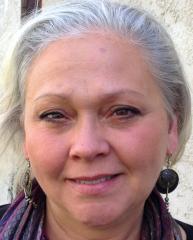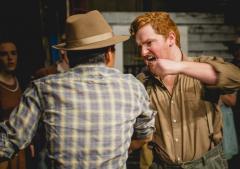On June 21, downtown Davis will host the fourth annual Davis Music Fest. On today’s show Kyle Monhollen, part of the Davis Live Music Collective and one of the festival’s organizers, talks about this year’s concerts and related subjects, including how they choose the lineup and why they want to bring more live music to Davis. He also updates us on last year's look at creating a permanent live music venue downtown; even just the cost of the sprinklers ended up looking pretty pricey.
|
The names of departed Davis businesses come easily to local beauty-salon owner Gerri Adler (pictured outside the I Street home where she grew up in the 1950s and '60s). On the walking tours she leads downtown, she describes places and people now gone who once epitomized Davis, the ways the town has changed, and people whose names we see today on buildings or street signs. Listen in as she talks about growing up in Davis, a town she still loves.
|
Drink a 20-ounce regular soda daily for a week, and you’ll consume as much sugar as you see in this one-quart Mason jar. On today’s program Harold Goldstein, executive director of the Davis-based California Center for Public Health Advocacy, talks about their efforts to tame the tide of sugar in the name of public health.
|
This spring, Raise the Wage Davis is collecting signatures for a November ballot initiative to increase the minimum wage inside Davis to $15 per hour by Jan. 1, 2016. On today’s Davisville, Neil Ruud, volunteer coordinator for the group, discusses their goals, plans, and why they chose $15. He also fields questions about the impact on employment inside the city.
|
 Meet Olaf. He’s a fool. Paul DelBene (shown here) knows because he created the character, and he’ll bring Olaf onstage for three “An Evening with Olaf” performances April 4-6 to benefit the Cesar Chavez school PTA and Davis Schools Foundation. On today’s program we talk about the shows, DelBene’s work (mostly in Europe), clown boot camp, clown college, performing for Pixar … and the value Davis could get from a small professional multi-functional venue, of maybe 200 to 300 seats, for music, performances, dances, and more. Meet Olaf. He’s a fool. Paul DelBene (shown here) knows because he created the character, and he’ll bring Olaf onstage for three “An Evening with Olaf” performances April 4-6 to benefit the Cesar Chavez school PTA and Davis Schools Foundation. On today’s program we talk about the shows, DelBene’s work (mostly in Europe), clown boot camp, clown college, performing for Pixar … and the value Davis could get from a small professional multi-functional venue, of maybe 200 to 300 seats, for music, performances, dances, and more.
|
|
|
 The city of Davis, facing a $5 million yearly deficit and a backlog of deferred road repairs (this photo, shot through a windshield, shows Olive Drive), has asked voters to boost the city sales tax by a half-cent per dollar starting this fall. Citywide votes on water rates and possibly a new city parcel tax are also in the works this year. On today’s show, Davis Vanguard blogger David Greenwald--who has written extensively about the city's finances--talks about how the city dug this hole for itself, the options, and where we go from here. The city of Davis, facing a $5 million yearly deficit and a backlog of deferred road repairs (this photo, shot through a windshield, shows Olive Drive), has asked voters to boost the city sales tax by a half-cent per dollar starting this fall. Citywide votes on water rates and possibly a new city parcel tax are also in the works this year. On today’s show, Davis Vanguard blogger David Greenwald--who has written extensively about the city's finances--talks about how the city dug this hole for itself, the options, and where we go from here.
|
 Debra DeAngelo, managing editor of The Winters Express, also writes the often-feisty "Because I Say So" opinion column that appears every Sunday in the Davis Enterprise. Today we talk about the column, her work, misperceptions that Davis and Winters have about each other, and more.
Debra DeAngelo, managing editor of The Winters Express, also writes the often-feisty "Because I Say So" opinion column that appears every Sunday in the Davis Enterprise. Today we talk about the column, her work, misperceptions that Davis and Winters have about each other, and more.
|
 A customer who doesn't want to smell bacon. Product questions. Criticism of music played in the store. The Suggestion Box at the Davis Food Co-op, one of Davis’ iconic businesses, fields 80 contacts a month as part of one of the most basic transactions at any business: Dealing with the public. In this case, the Davis public. On today’s Davisville we talk with Membership Director Doug Walter about keeping the customer happy, plus related subjects concerning the Co-op, expectations for choice, and more.
A customer who doesn't want to smell bacon. Product questions. Criticism of music played in the store. The Suggestion Box at the Davis Food Co-op, one of Davis’ iconic businesses, fields 80 contacts a month as part of one of the most basic transactions at any business: Dealing with the public. In this case, the Davis public. On today’s Davisville we talk with Membership Director Doug Walter about keeping the customer happy, plus related subjects concerning the Co-op, expectations for choice, and more.
|
 Explorit Science Center, founded in Davis 32 years ago to be "a place [where] people could find out how science is part of our everyday lives," nearly had to close this winter for lack of money. In today’s program, Lars Anderson—Explorit’s board president and interim executive director—talks about how they plan to recover. Explorit Science Center, founded in Davis 32 years ago to be "a place [where] people could find out how science is part of our everyday lives," nearly had to close this winter for lack of money. In today’s program, Lars Anderson—Explorit’s board president and interim executive director—talks about how they plan to recover.
|







